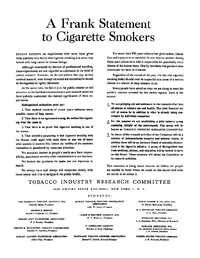A Frank Statement
| Wikisource has original text related to this article: |

A Frank Statement to Cigarette Smokers was a historic advertisement run by major American tobacco companies on January 4, 1954 in response to a study showing that cigarette tar caused cancerous tumors on mouse skin.[1] The advertisement ran in more than 400 newspapers throughout the U.S. aimed at an estimated 43 million people. It was the first in a campaign to dispute reports that smoking cigarettes could cause lung cancer and had other dangerous health effects.[1]
The public relations firm Hill & Knowlton created the advertisement after a meeting in New York late in 1953 between them and Paul Hahn (head of American Tobacco) and other tobacco executives. The tobacco industry followed it with other advertisements expressing doubt about scientific research linking disease and smoking.[2]
Historical context
Reports of a link between tobacco and lung cancer had emerged as early as 1912, although until the 1950s, the evidence was circumstantial. In the early 1950s, Richard Doll released the results of the British Doctors Study which showed a 20-fold increase in lung cancer susceptibility in smokers. In 1953, an animal study by Ernst Wynder found that tobacco tar was carcinogenic when applied to the skin of mice.[3] The increased evidence that tobacco causes cancer was covered in the Reader's Digest article, Cancer by the carton.[2][4] This article provoked a health scare, resulting in a small drop in consumption, and a fall in stock prices. In this context, some tobacco industry executives, led by Paul Hahn, head of American Tobacco, met with Hill & Knowlton, who created A Frank Statement.[2]
Claims
The advertisement claimed:
- That medical research of recent years indicates many possible causes of lung cancer.
- That there is no agreement among the authorities regarding what the cause is.
- That there is no proof that cigarette smoking is one of the causes.
- That statistics purporting to link cigarette smoking with the disease could apply with equal force to any one of many other aspects of modern life. Indeed the validity of the statistics themselves is questioned by numerous scientists.
Promises
The advertisement also made several promises on behalf of the tobacco industry which were later disputed by the scientific community. A Frank Statement says that its authors believed that the products they made were safe. In a 2002 assessment[5] of the promises made by the advertisement, it was concluded that some tobacco industry scientists had concluded that there was a causal relationship between tobacco and cancer. The tobacco industry did not acknowledge a causal link with cancer until 1999.
The statement also pledged "aid and assistance to the research effort into all phases of tobacco use and health", and announced the establishment of the Tobacco Industry Research Committee (TIRC) towards that aim. Much of the TIRC funded research was not directly connected to smoking and health, and neither it nor its successor, the Council for Tobacco Research, ever acknowledged a proven link between smoking and serious and life-threatening illness. Despite the lack of relevance of many TIRC funded research to the health effects of smoking, some in the tobacco industry publicized their funding of the TIRC to reassure the public.[5]
Finally, the advertisement promised that the industry "always have and always will cooperate closely with those whose task it is to safeguard the public health". According to Cummings, Morley, and Hyland,[5] "there is abundant evidence that the tobacco industry went to great lengths to undermine tobacco control efforts of the public health community." An example of this is a memo from the vice-president to the president of the Tobacco Institute in which the industry's strategy was described as "creating doubt about the health charge without actually denying it", and "advocating the public's right to smoke, without actually urging them to take up the practice".[5]
See also
References
- 1 2 Daily Doc: TI, Jan 4, 1954: The 'Frank Statement' of 1954. Tobacco.org. 30 September 2000. Accessed 17 July 2009.
- 1 2 3 Derthick, Martha A. Up in smoke : from legislation to litigation in tobacco politics (3rd ed.). Washington, D.C.: CQ Press. pp. 33–41. ISBN 1452202230.
- ↑ Nutt, David (2012). Drugs – without the hot air : minimising the harms of legal and illegal drugs. Cambridge, England: UIT. pp. 201–202. ISBN 1906860165.
- ↑ Norr, Roy. "Cancer by the carton". Reader's Digest. Retrieved 1 January 2014.
- 1 2 3 4 Cummings, K M; Morley, C P; Hyland, A (1 March 2002). "Failed promises of the cigarette industry and its effect on consumer misperceptions about the health risks of smoking". Tobacco Control. 11 (Supplement 1): i110–i117. doi:10.1136/tc.11.suppl_1.i110. PMID 11893821.